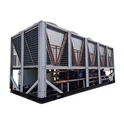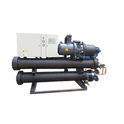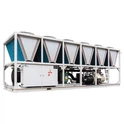Constant temperature and humidity air conditioningis an advanced cooling system that is mainly used to maintain constant temperature and humidity levels in a room or building. Unlike traditional air conditioning units that can only adjust temperature, this equipment is usually used in industrial and commercial scenarios. These systems Equipped with additional sensors and control mechanisms that allow them to monitor and regulate temperature and humidity levels. This article will take you through all the information you need to know about constant temperature and humidity air conditioners, whether you are buying or even studying this article can help you.

Temperature And Humidity Control Crafts
Constant temperature and humidity air conditioning is one of the process air conditioners. Strict air conditioning that controls room temperature, humidity changes and regional deviations is called constant temperature and humidity air conditioning.
The temperature and relative humidity of a room (or partition) of a constant temperature and humidity air conditioner determined according to process requirements are called the air conditioning temperature and relative humidity base. The large difference (T and ) between the temperature and relative humidity in an air-conditioned room (or area) from the temperature and humidity base within a period of time is called the accuracy of the air conditioner, that is, the variable range. Some special processes or scientific experiments require temperature, humidity The variation deviation and regional deviation are very small. For example, the winding process of polycool filament requires a temperature of 23°C, a fluctuation of 0.5%, a relative humidity of 71%, and a fluctuation of 5%.
Constant temperature and humidity air conditioning requires temperature, mixing base and air conditioning accuracy (for example, T=230.5, RH=71% 5%, etc.). For example, a level 1 front bed should keep the temperature at 20° in winter and summer and the relative humidity at 40% to 65%. But there are also relative humidity requirements. For example, the physical laboratory of a man-made fiber factory requires a relative humidity of 65% and a temperature of 20°. The accuracy of temperature control is not high at this time, but temperature fluctuations will cause fluctuations in relative humidity. At 20 o'clock, the temperature fluctuation is 1, and the relative humidity fluctuation is about 4%, which will exceed the fluctuation range of relative humidity, so these air conditioners must control the temperature accuracy at the same time.




Constant Temperature And Humidity Air Conditioning Working Principle
The working principle of a constant temperature and humidity air conditioner is to circulate air through a series of filters and cooling coils. When the air passes through the filter, various dust, pollen and other pollutants in the air will be filtered out by the filter element of the equipment, and clean air will be discharged.

Different Types Of Constant Temperature And Humidity Air Conditioners
There are many different types of constant temperature and humidity air conditioners in terms of application scenarios and product features.
Our company mainly produces the following four types of constant temperature and humidity air conditioners:
1:Ordinary type
4:low temperature and low humidity type
Wide Range Of Application Scenarios
Constant temperature and humidity air conditioners are widely used in electronics, optical equipment, cosmetics, medical and health care, biopharmaceuticals, food manufacturing, various measurement, testing and laboratories and other fields.

Using Benefits
Improve Indoor Air Quality: By filtering pollutants and regulating humidity levels, these systems can help improve the overall air quality of your home or office, reducing the risk of respiratory problems and allergies.
Improve Comfort: Maintaining constant temperature and humidity levels helps ensure the comfort of those in the room.
Energy Saving: Advanced sensors and precise control systems can operate more efficiently than traditional devices, thereby saving energy and lowering utility bills.
Long Service Life: A properly maintained constant temperature and humidity air conditioner lasts longer than a traditional air conditioner, resulting in greater value.
Precautions
The air conditioning system has requirements on the supply air temperature difference and blowing air volume. Obviously, if the supply air flow is large and the supply air temperature difference is small, the temperature in the air-conditioned area may be uniform. In other words, the temperature deviation in the area can be reduced and the air flow distribution can be stabilized. Therefore, if the control accuracy of temperature and humidity is high, a larger supply air flow and a smaller supply air temperature difference need to be adopted.
When the temperature control accuracy is specified to be 0.1~0.2, a ventilation volume and supply air temperature difference of more than 12h-1 are required. When the control accuracy is 0.5, the supply air flow should not be less than 8h-1. The supply air temperature difference should be 3~6. When the control accuracy is 1, the air intake volume should not be less than 5h-1, and the supply air temperature difference should be 6~9. The temperature control accuracy must be greater than 1, and the supply air temperature difference must be less than or equal to 15.
The above supply air temperature difference is applicable to air-conditioned areas with side supply and diffuser leveled air distribution.
In Conclusion
Constant temperature and humidity air conditioning is an advanced cooling system that can help improve indoor air quality and increase comfort, while also saving energy and extending service life; by understanding how these systems work and the different classifications of their products, you can or make the best decision when choosing air conditioning for your office.







